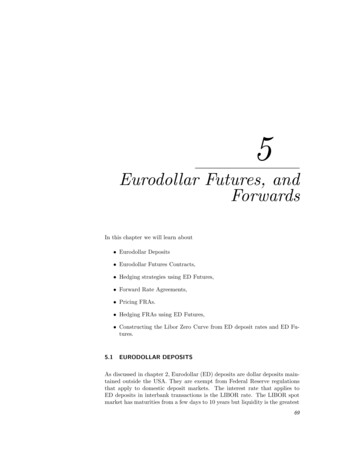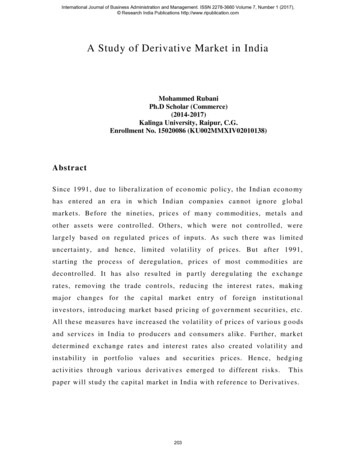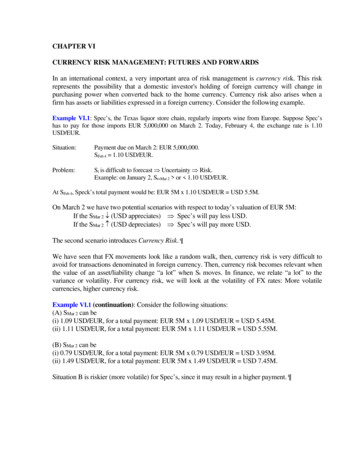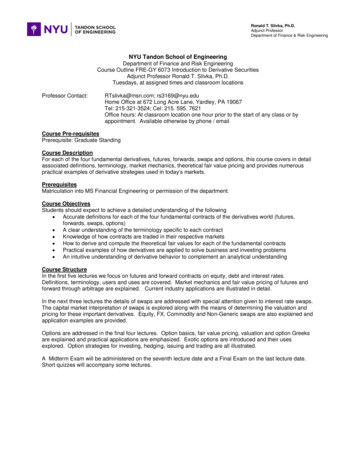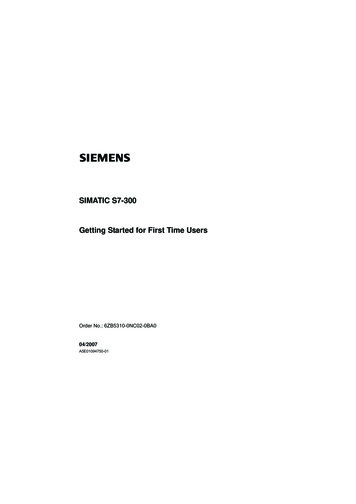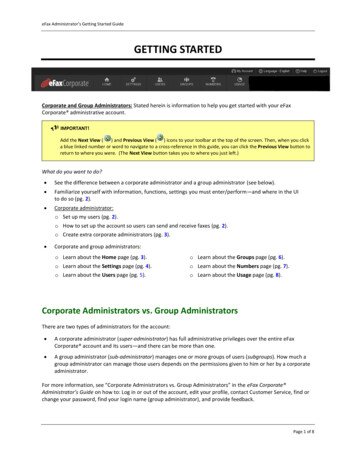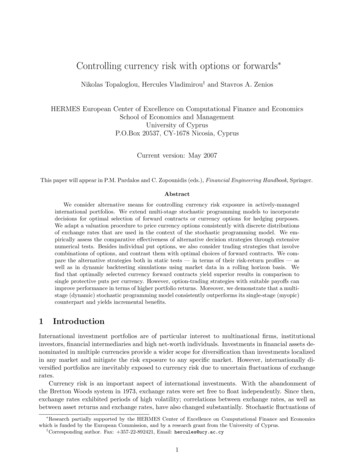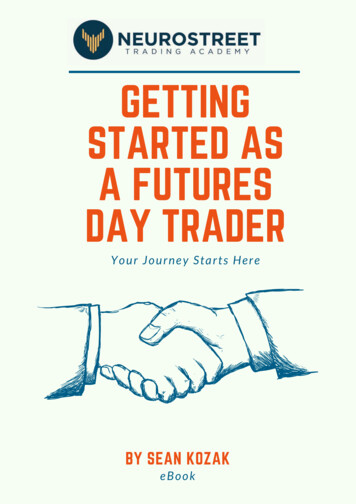
Transcription
GETTINGSTARTED ASA FUTURESDAY TRADERYour Journey Starts HereBY SEAN KOZAKeBook
2TABLE OF CONTENTSChapter 1:Introduction to Trading3Chapter 2:Order Types & Trade Basics5Chapter 3:Futures Explained Pt:16Chapter 4:Futures Explained Pt:29Chapter 5:Futures Explained Pt:312Chapter 6:Futures Explained Pt:412Chapter 7:Trading Strategies Basics14Chapter 8:Economic Calendars15Chapter 9:Trade Statistics16Chapter 10: Creating A Trade Plan18Chapter 11: Skill Development Process20
Chapter 1: Introduction to TradingTrading vs InvestingWhat is Trading?3Trading is buying and selling securities based on specific strategies.Trading uses technical analysis to identify low risk, high reward, high probability trade setups and strategiesTrading utilizes advanced software and indicators to perform accurate analysis or trade setups and managementTrading is not limited to day trading. It can include short term intra-swing trading or long-term position trading.Trading is a form of business that allows for extraction of income and does not hinge on a % growth of capitalPros & Cons of Trading?PROS:1. You can make money in bullish and bearish markets2. You can actively qualify and quantify the risk3. You can maintain a high liquidity of personal assets4. You can utilize multiple strategies and setups to profit from opportunities5. You can make your own financial decisions6. You can focus on extracting income from trading, not % returnsCONS:1. Taxation is a liability if your corporate structure is not set up properly and youare trading full time for an income.2. More decision making required due to being more active in the markets3. Requires active brain focus in order to process quick decision making.Pros & Cons of Investing?PROS:1. Capital gains taxation (50% of profits taxed) – Demographic Location Specific.(Canada)2.Less decision making due to being less active in the markets.CONS:1.You are most likely to only add to a position in a bull market.2.You may be exposed to high degrees of risk due to market swings.3.You may Lack flexibility in strategies and setups.4.Your assets are usually tied up for long periods of time.5.You may depend on someone else's analysis and decision making.6.You may find difficulty selecting the right investment.7.You may experience average or sub-par returns after competing against inflation, fees, and taxes.Risk Scenarios of TradingPrice risk (price fluctuations) Increase and decrease in price movementLiquidity risk (volume) High volume and low volume trading timesCredit/capital risk (insufficient capital) Trading the wrong markets or being undercapitalizedCapital markets risk (global risk) Global catalysts (war, political, natural disaster)Volatility risk (news risk) Federal reserve, economic data, business information
Trader Type vs Trader StyleA trader’s type relates to their time horizon,goals, commitment level and availability to trade.Our strategies are universal and can applied to Scalping/Daytrading & Intra-Swing/Daytrading.A trader’s style relates to their trading strategy.Our Strategies Apply to:Trend TradingCounter Trend TradingReversalsMomentum4
Chapter 2: Order Types & Trade BasicsOrder TypesLimit order: A limit order is one that guarantees price, but not execution.Market order: A market order is one that guarantees execution at the current market price, given itspriority in the trading order book.Stop order: Also referred to as a stop-loss order, is your risk management tool. A stop is used to triggera market order to exit a trade if price trades against you.Trailing Stop Order: A stop-loss order that trails price in order to eliminate risk and to protect profits.The trailing stop price is adjusted as the price fluctuates and acts a market order for riskmanagement.Day Order: An order that remains open until the end of the trading day and then is canceled by thebroker/trade floor.Good till Canceled (GTC) These orders are also known as ‘open orders’. This type of order is alwaysworking on the floor of the exchange unless it is executed, canceled by the client, or replaced by anotherorder. When you place an order with a broker, it is assumed a day order and will expire at the close ofthat markets trading day. If you wish to have an order working beyond the day you place it, you mustspecify it to be GTC.One-Cancels-Other (OCO): A pair of orders stipulating that if one order is executed, then the otherorder is automatically canceled. A (OCO) combines a stop order and limit order. When either the stop orlimit level is reached, and the order is executed, the other order will be automatically canceled.Traders use OCO orders to mitigate risk and plan trades in advance.Long Position/TradeLong trades (Look for price to rise)When we take long trades, we are buying the security with the outlook of capital appreciation.Short Position/TradeShort trades (Look for price to decline)When we take short trades, we are actually selling the security with the outlook of capital depreciation.5
Chapter 3: Futures Explained Pt:1Exchanges/Settlement/WatchlistsFutures ExchangesFutures trade on different exchanges than Stocks, Options and Forex.CBOT (Chicago Board of Trade) is the 1st and oldest exchange in the world.CME (Chicago Mercantile Exchange) in 2007 became the largest exchange in the world and purchased the CBOT.ICE (Intercontinental Exchange) is the youngest and is only electronic.NYBOT (New York Board of Trade) is owned by (ICE).Currency FuturesTreasuriesMeatsAgriculturesStock IndexesNew York Exchanges trade:Precious MetalsPetroleumAgriculturesSoftsSofts Include:CottonCocoaCoffeeSugarOrange JuiceWhat are Futures?Where contracts are agreed upon to buy or sell something with the terms identified now but the paymentand delivery takes place at a future date.If you buy a futures contract you are agreeing to buy something, from a seller, for future delivery, at aspecific price based on an underlying asset.If you sell a futures contract you are agreeing to sell something, to a buyer, for future possession, at aspecific price based on an underlying asset.When the contract ends one party purchases or sells the goods and the other is responsible for itsdelivery as noted in the contract.6
What is Settlement?Settlement is the act of fulfilling the contract. Some contracts are cash settled and somewith physical deliveryCash settled contracts use an external reference to settle the contract between the buyer and seller.Physical settlement contracts require the trader to make or receive delivery if they have an openposition at expiration.Ex:Equity indexes are cash settled based on the closing price of the index on the settlement date.Corn, Oil, Wheat, Cocoa are examples of underlying assets that require physical settlement and would bereceived or delivered by the trader after the settlement date.Day Trading FuturesThe goal of day trading futures is to buy and sell futures contracts based off the volatility and pricemovement of specific markets.We are not interested in delivering or receiving the underlying asset we only concern ourselves with theelectronic contracts being traded.We are not concerned with fundamental analysis or valuations.We strictly focus on technical analysis and deployment of trading strategiesWe use price action, volume, candlesticks, indicators and specific software to take advantage ofopportunities intraday either for an income or for capital growth.E-minis & Full ContractsE-Mini’s are a certain type of futures contractThe “E” represents that it is electronically traded.The “Mini” represents that the contract is typically 1/5 the size of the standard contract.E-mini’s provide faster fills and better prices than full sized contractsFull size contracts are larger contracts traded by larger traders and institutionsPit tradedLarger leverageOnly used for making large size trades due to liquidity requirementsTop Reasons To Trade E-minis and Global FuturesGood volatilityVery LiquidLeverageNo short sale restrictionsNo day trading restrictionsPrice transparencyGlobal coverage23 hours/day 6 days/weekLess capital requirements to trade7
Building a Trading WatchlistFor this course, we will introduce you to the contractstraded with the most liquidity and market exposure.Use this list as your starting point for building yourwatchlist of markets to trade.Stock Market Indexes:ES – S&P 500NQ – NasdaqRTY – RussellYM – Dow JonesFDAX – DAX IndexEnergies & Commodities:CL – OilGC – GoldCurrency Futures:6A – Aussie Dollar6B – British Pound6E – Euro Dollar8
Chapter 4: Futures Explained Pt:2Contract SpecificationsEach Futures Contract Varies Based on:Contract sizeTick increments per pointDollar value per tickDollar value per point.Knowing this information helps identify which contracts will be suitable to trade for each person’s risktolerance and account size.Ex:Someone with a smaller account may consider trading the NQ or the YM which have a smaller dollar valueper point/tick.Someone with a larger account may consider trading contracts with larger parameters such as CL or TF asthey have a larger dollar value per point/tick.You can use our manual position sizing template in the downloads section as we have included all the majormarkets we focus on as a quick reference tool for you to access these contract specifications and riskmetrics.Market Example (ES)Market Example (NQ)9
Market Example (YM)10Market Example (CL)Market Example (GC)
Market Example (6A)11Market Example (6B)Market Example (6E)
Chapter 5: Futures Explained Pt:3Expiration & Contract RolloverContract ExpirationEach futures contract/market has an expiration date/month.Expiration takes place on the 3rd Friday of the expiration month at the close of the business day.The week that ends on the 3rd Friday is considered the roll-over period.Roll Over is where traders roll over their positions to the next active contract to avoid delivery or receipt ofthe underlying asset.It’s wise to switch to the next most actively traded contract 1-2 days prior to expiration.Rollover & VolumeStock Indexes expire quarterly (March/June/September/December)Treasuries expire quarterly (March/June/September/December)Currencies expire quarterly (March/June/September/December)Energies expire monthly (Monthly)Agriculture/Metals/Softs/Meats expire on different schedules.Make sure you review the appropriate dates according to the contracts you trade.Always trade the contract with the most volumeFront month contracts nearest expirationChapter 6: Futures Explained Pt:4Margins & Trading TimesUnderstanding MarginsMargin is referred to as the cost of putting on a trade. It is the amount set aside in your account foreach contract you trade. Your margin varies by the market and the session time (day/overnight). Marginfor futures is different than with stocks because we aren’t paying interest and we are not borrowingmoney. We are setting money aside that is already in our account. Our margin acts as a security depositfor the trades we take because futures are highly leveraged assets.Initial Margin – The minimum capital amount needed to open a trade.Maintenance Margin – The minimum capital amount needed to keep the trade open. If your accountfalls below this amount your broker can liquidate your position without notice.Ex: Initial Margin 5000Maintenance Margin 3000If your account lost more than 2000 your broker will liquidate the positionExcess Margin – money left over in your account in excess of the initial margin requirements to openpositions.Day Trading Margins – Is the amount set by your broker in order to enter into a trade in value percontract during market trading hours. the day trading margins return to the initial margin requirementsonce the market closes. Once the market re-opens your broker will switch back to day trading marginrequirements.Please visit your Brokerage website and platform resources to learn their basic requirements.12
Market Hours / Market SessionsOne benefit to trading futures is that it provides flexibility with trading times available to trade.Unlike equities and options markets, global futures trading is open six days a week for 23 hours a day.This provides multiple opportunities for traders to trade different market sessions. (US/Aussie/Asia/Euro)A benefit to trading futures is that you can choose to trade faster market sessions like the (US/Euro) oryou can trade the slower market sessions like the (Aussie/Asia).Market Trading Times (Suggestions)US Market Session: (9:30 am) – (4:00 pm) (FAST SESSION)(ES/NQ/YM/RTY) Monday – Friday: (8:00 am – 11:45 am)/(1:00 - 3:45 pm)(GC) Monday – Friday: (7:00 am – 11:45 am)/(1:00 pm) – (2:00 pm)(CL) Monday – Friday: (7:00 am – 11:45 am)/(1:00 pm) – (2:00 pm)(6A) Monday – Friday: (8:00 am – 11:00 am)(6B) Monday – Friday: (8:00 am – 11:00 am)(6E) Monday – Friday: (8:00 am – 11:00 am)Aussie and Asian Session: (6:30 pm) – (3:00 am) (SLOW SESSION)(GC) Sunday – Friday: (7:30 pm – 11:00 pm)/(2:00 am) – (5:00 am)(CL) Sunday – Friday: (7:30 pm – 11:00 pm)/(2:00 am) – (5:00 am)(6A) Sunday – Friday: (7:30 pm – 11:00 pm)/(2:00 am) – (5:00 am)(6B) Sunday – Friday: (7:30 pm – 11:00 pm)/(2:00 am) – (5:00 am)(6E) Sunday – Friday: (7:30 pm – 11:00 pm)/(2:00 am) – (5:00 am)European Session: (3:00 am) – (9:30 am) (FAST SESSION)(GC) Sunday – Friday: (2:00 am – 5:00 am)/(7:00 am – 9:25 am)(CL) Sunday – Friday: (7:00 am – 9:25 am)(6A) Sunday – Friday: (2:00 am – 5:00 am)/(6:30 am – 9:25 am)(6B) Sunday – Friday: (2:00 am – 5:00 am)/(6:30 am – 9:25 am)(6E) Sunday – Friday: (3:00 am – 5:00 am)/(6:30 am – 9:25 am)(ES/NQ/YM/RTY) Monday – Friday: (8:00 am – 9:25 am)THE ABOVE TIMES ARE DESCRIBED IN (EST)13
Chapter 7: Trading Strategies BasicsWhat is a Trading Strategy?A Trading Strategy is the application of making money trading. Despite the differenttypes of traders & strategies, there are several aspects that remain a constant amongall traders:Trade selection & market selectionPosition sizing & money managementProbability analysisRisk management & trade managementThe need for a trading planStrategy TypesTraders have options towards defining how they approach the markets. Some prefer active involvement andothers rely on less human interaction by way of computer application.3 MAIN CATEGORIES OF STRATEGIES:Discretionary (subjective/hands on)Aligns information, price & indicators to form a decision to buy/sell.Automated (pre-built/hands off)Create computer rules-based parameters to trade robotically.Rules based combination (subjective/pre-built/hands on)Combines discretionary decision making using pre-built rules based parameters. Allows for human intuitionwith rules base structure.What Makes a Trading Strategy?A defined set of rules around:–Entry–Exit–Trade selection–Directional bias–Market SelectionA defined set of rules around:–Capital allocation–Position sizing–Money managementA defined set of rules around:–Risk management–Trade management–Routine, trade planning and discipline14
Chapter 8: Economic CalendarsNews Volatility RiskEconomic Calendars:Traders use economic calendars to gauge expected market volatility.Traders use economic calendars to plan out their trading times and daily/weekly trading schedule.Traders use economic calendars to prepare for news event risk so they can avoid unnecessary volatilityin the markets.Traders concern themselves with economic calendars surrounding news events that include:Federal BanksEconomic DataGovernment PolicyGlobal News Announcements15Traders should concern themselves with following information when analyzing economic calendars & planningtheir trading schedule:The economic report that is being releasedThe time the report is being releasedThe forecasted number expected to be releasedThe actual number that is releasedWhether the actual number was ( ) or (-) to the forecastThe impact the report may have on the market volatility (low/med/high)The rules we have or chose to implement around trading times and news event risk
Chapter 9: Trade StatisticsJournaling & ReviewTrading StatsTrading platforms provide a simple and effective way to monitor our trading process.As a trader we can track our success and roadblocks by looking at our trade statistics and our tradinglog/journal.We can look for patterns to see if we can identify strengths and weaknesses that need our attention.Some very important elements to pay attention to when analyzing your trade stats are:1.Net profit2.Gross profit/Loss3.Commissions4.Max drawdown %5.# of trades per day6.% Profitable7.# of wins/# of losses (Win/Loss Ratio)8.Profit factor9.Average time in market10. Largest winning/losing trade16It is important to get into the routine of logging your trades daily. We provide a master trading journal for you tolog your trades, so you can track your performance and decision-making behavior.You can also take screen shots of your trades to look back over and assess your trading, so you can learn from yourstrengths and weaknesses.You should review your stats after a given period to adjust your account risk and position sizing.
Journal/Log Examples17
Chapter 10: Creating A Trade Plan3 Pillars183 Pillars of A Successful Trade Plan:Pillar #1: Trading Business PlanLooks at business objectives and structurePillar #2: Trading Action PlanLooks at the application of the trading businessPillar #3: Trading Psychology PlanLooks at our physical and psychological componentPillar#1: Business Plan:Business Overview & ObjectiveYour WhyMission StatementVision StatementTrading StyleCorporate StructureBroker & DataBusiness HoursEquipmentResourcesMarkets & Assets TradedCapitalization & Margin RatesPillar #2: Action Plan:Preferred Market Trading ConditionsPosition Sizing ModelsRisk ManagementMarket StrategyTrading ProcessTrade Setup/Rules/PicturesCapital/Drawdown Rules & ProceduresMarket Routine/Pre-PostTrading Laws/Personal RulesPillar #3: Psychology/Development Plan:Self-AcknowledgementPersonal StrengthsPersonal WeaknessesTrading StrengthsTrading WeaknessesObjectives to Capitalize & ChangeBusiness EvaluationPersonal EvaluationPersonal PsychologyExercise RoutineCognitive TrainingWhy Have Rules?Trading is a business of risk management. In order to stay consistent running a successful tradingbusiness we need to have rules around how we trade, how we manage risk and how we run our trades.Traders who don’t have rules or structure lose money as a direct result of trading becoming more of ahobby rather than a business.
Rules & Laws List (Examples):1. I will not trade into economic of fed bank news announcements 5M Prior/5M Post2. With session open/close I will not enter a position 5M Prior/5M Post3. I will only trade confirmed setups4. I will only buy in demand and sell in supply5. I will use HTF/Curve/Trend/Momentum to confirm directional bias6. I will never trade without my entry and exit predetermined7. I will only trade my plan8. I will not force trades9. I will not add to losing trades10. I will wait for the market to prove itself if I am unsure about my trade or the direction.11. I will not chase price12. I will not listen to the media or outside influence13. I will not trade if I am not rested and my routine is not completed prior to trading14. I will not revenge trade to make back losses15. I will stop trading if I feel to emotional to make sound trading decisions16. I will not interfere with my plan and decision making prior to letting the trade play out.17. I will not hyper-trade/overtrade18. I will trade for small/large wins, to break even & for small losses but never large losses.19. I will remain healthy, active and in a good frame of mind, so I can enjoy my work & have balance20. I will always remain accountable to my trading business and decisions19
Chapter 11: Skill Development ProcessLearning Curve & Application3 Stages of Trade Emotions:As professional traders we are constantly experiencing challenges both in the application aspect of tradingand the emotional aspect of personal development.Trading is a performance-based business. In order to develop we must identify the possible stages of emotionswe will experience while trading.During every trade at some point a trader is likely to feel the following:HOPE – We hope the trade turns around and comes back from negative to positiveFEAR – Fear sets in while in a trade and we simply hope to B/EDESPERATION – We become completely paralyzed by the pain of loss which forces us to just get out ofthe trade regardless of the loss or state of the trade (Self Sabotage)They will happen no matter who we are or what our experience level isThe solution is to know this will happen in advance, so we can plan to manage ourselves accordinglyas we trade.Learning Curve:As you approach trading it’s crucial to not skip steps in the learning process.Doing practice exercises, marking up your charts, doing bar-by-bar analysis in simulation and marketreplay will drastically improve your chance of success.Often, traders will learn the educational concepts and skip the skill development phase. Trading livemarkets prematurely causes traders to set themselves up for failure.If you treat this seriously and want a positive outcome it is important to follow this process while beingpatient to learn and develop your skill. Those who do the work will be rewarded by their skill andapplication.How to Become A Great Trader:In order to get to the “Unconscious Competence” level, we need to treat trading like a business not ahobby!When taking trades, only take the best setupsWhen trading, practice patience before actionWhen planning trades, think of risk firstBefore trading live, practice, practice, practice!Embrace the process. It’s ok to make mistakes along the way.Make sure you start with healthy expectations and work towards improvement, don’t expect perfection orcertainty EVER!When you take a trade, log it in your journal and review itAfter you have an extended time of trades in your journal, go back and evaluate your decision making tolook for /- patterns and areas that need improvement.20
Learning Matrix21Emotional Tools & Practice Resources:Consider reading: (Psychology)Trading in The Zone by “Mark Douglas”Market Replay / Bar-By-Bar Analysis Sim LiveEach student should trade on simulation for at least 4 to 6 weeks or until they are able to document thefollowing accurately:ConfidenceConsistencyPatienceRulesTrade SelectionProfitabilityPositive BeliefTrustNext StepsPut an end to late signals and missed trades. We trade live!https://bit.ly/3fyOBCV
We use price action, volume, candlesticks, indicators and specific software to take advantage of opportunities intraday either for an income or for capital growth. The goal of day trading futures is to buy and sell futures contracts based off the volatility and price movement of specific markets. Day Trading Futures


